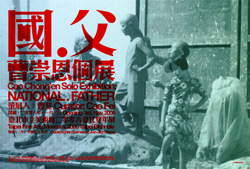

 Cao Fei is in many ways the quintessentially twenty-first century artist. In her relatively short career, she has already developed, among other interests, a somewhat complicated mythology about hip-hop music, which she recently demonstrated in a three-continent research project into cross-cultural rap. By 2005, when Hip-Hop (the exhibition) reached New York, where hip-hop (the music) began, Cao Fei’s investigation had already attained so many multiple meanings that her musical discovery ended up being a Chinatown trio known as Notorious MSG. Setting up a live gallery performance, and filming Notorious MSG in their element, Cao Fei tipped the notion of authenticity on its head, while continuing to assert her initial conceit, which is that hip-hop is a global phenomenon capable of bringing divergent peoples together, even when it no longer uses English for its rhymes.
Cao Fei is in many ways the quintessentially twenty-first century artist. In her relatively short career, she has already developed, among other interests, a somewhat complicated mythology about hip-hop music, which she recently demonstrated in a three-continent research project into cross-cultural rap. By 2005, when Hip-Hop (the exhibition) reached New York, where hip-hop (the music) began, Cao Fei’s investigation had already attained so many multiple meanings that her musical discovery ended up being a Chinatown trio known as Notorious MSG. Setting up a live gallery performance, and filming Notorious MSG in their element, Cao Fei tipped the notion of authenticity on its head, while continuing to assert her initial conceit, which is that hip-hop is a global phenomenon capable of bringing divergent peoples together, even when it no longer uses English for its rhymes.
For the 2006 Taipei Biennial, Cao Fei has developed a proposal that incorporates a similarly optimistic vision. Based on the sculptural career of her father, who before his retirement often created busts and statues of Dr. Sun Yat-Sen, Cao Fei’s working premise is that since Dr. Sun is one of those rare symbols that effectively allows Taiwan and China to co-exist peacefully, there is a special poetry implicit in creating a temporary pavilion within the Taipei Fine Arts Museum, so that sculptures bearing Dr. Sun’s likeness, imported for the occasion from the mainland, can be appreciated by the people of Taiwan.
To prepare this undertaking, the artist has very painstakingly downplayed all the political tensions that seem to weigh down cross-strait relations, through her straightforward insistence that there are always symbols that enable people to intercommunicate, even when they are at loggerheads over the fundamental nature of their relationship with one another. Cao Fei’s Taipei project also offers a credible basis for considering the very complex issues of artistic patrimony, especially as these are faced by a generation of Chinese artists who are only a generation away from the production of officially sanctioned ‘revolutionary’ art, and are now being asked to construct the artistic bridge tying China’s artistic future with the rest of the planet. Under the budgen of such heavy expectations, Cao Fei has responded by asking us to take a closer look at the more recent traditions from which her generation’s artistic identity has emerged.